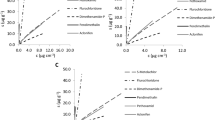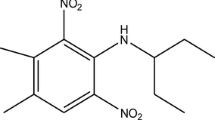Abstract.
The results of a study on adsorption of phenol in granite residual soil and kaolinite are presented. Experiments were conducted using batch adsorption procedures at low phenol concentrations, i.e. from 0.8 to 10 mg/L, and at higher concentrations, i.e. from 10 to 100 mg/L. The interactions have been studied with respect to the linear, Freundlich and Langmuir adsorption isotherms. It is found that the residual soil possesses greater adsorption capacity compared to that of kaolinite. For example, the linear partition coefficient, K d, for the residual soil–phenol interaction is about 10.48 L/kg while the corresponding value for the kaolinite–phenol system is 1.18 L/kg. The highly non-linear relationship, which covers the whole set of data, was transformed linearly using the linearized Freundlich and Langmuir isotherms. The linearized Langmuir plot for low concentration data may be used to estimate the maximum adsorption capacity of the soil. From limited studies it is also concluded that the granite residual soil has a great potential for use as a soil liner material.
Résumé.
Les résultats d'une étude sur l'adsorption de phénol par des sols résiduels granitiques et la kaolinite sont présentés. Les expériences ont été conduites en réalisant des tests d'adsorption (tests conventionnels en batch) avec d'une part, des faibles concentrations de phénol, de 0,8 à 10 mg/l, et d'autre part, de plus fortes concentrations, de 10 à 100 mg/l. Les interactions ont été étudiées par référence aux isothermes d'adsorption de Freundlich et Langmuir. Il apparaît que le sol résiduel présente une plus grande capacité d'adsorption que la kaolinite. Par exemple, le coefficient de partition linéaire Kd, pour l'interaction sol résiduel–kaolinite est d'environ 10,48 l/kg tandis que la valeur correspondante pour le système kaolinite - phénol est de 1,18 l/kg. La relation fortement non linéaire, qui concerne l'ensemble des données, a été transformée en utilisant les isothermes linéarisées de Freundlich et Langmuir. La fonction linéarisée de Langmuir pour les faibles concentrations peut être utilisée pour estimer la capacité maximale d'adsorption du sol. A partir de ces quelques études on peut aussi conclure que le sol granitique résiduel présente un fort potentiel comme matériau de confinement.








Similar content being viewed by others
References
Acar YB, Li H, Gale RG (1992) Phenol removal from kaolinite by electrokinetics. J Geotech Eng ASCE 118(11):1837–1852
Bedient PB, Rifai HS, Newell CJ (1994) Ground water contamination: transport and remediation. Prentice Hall, Englewood Cliffs, New Jersey, 541 pp
Brady NC (1974) The nature and properties of soils, 8th edn. Macmillan, New York, 639 pp
Fetter CW (1988) Applied hydrogeology. Macmillan, New York, 592 pp
Freundlich H (1926) Colloid and capillary chemistry. Methuen, London
Gobbett DJ, Hutchison CS (1973) Geology of Peninsular Malaysia. Wiley-Interscience, New York, 439 pp
Holzlohner U, August H, Meggyes T (1997) Contaminant transport, fundamentals and minimisation. In: August H, Holzlohner U, Meggyes T (eds) Advanced landfill liner. Thomas Telford, London, pp 31–37
Karickhoff SW, Brown DS, Scott TA (1979) Sorption of hydrophobic pollutants on natural sediments. Water Res 13:241–248
Langmuir I (1918) The adsorption of gases on plane surfaces of glass, mica and platinum. J Am Chem Soc 40:1361–1382
McBride MB (2000) Chemisorption and precipitation reactions. In: Sumner ME (ed-in-chief) Handbook of soil science. CRC Press, Boca Raton, pp B265–B302
Mofiz SA (2000) Behavior of unreinforced and reinforced residual granite soil. PhD Thesis, Universiti Kebangsaan, Malaysia, 315 pp
Ponec V, Knor Z, Cerny S (1974) Adsorption on solids. Butterworths, London, 693 pp
Saltzman S, Yariv S (1975) Infrared study of sorption of phenol and p-nitrophenol by montmorillonite. Soil Sci Soc Am Proc 39(3):474-479
Shackelford CD (1993) Contaminant transport. In: Daniel DE (ed) Geotechnical practice for waste disposal. Chapman and Hall, London, pp 33–63
Taha MR (2001) Some aspects related to clean-up of contaminated soils. In: Proc Brownfield 2001, Institution of Engineers Malaysia, Petaling Jaya, Selangor, Malaysia
Taha MR, Debnath DK (1999) Interaction of cyanide with residual soil and kaolinite in batch adsorption tests. J Inst Eng Malaysia 60(3):49–57
Tan KH (1993) Principles of soil chemistry. Marcel Dekker, New York
Veith JA, Sposito G (1977) On the use of the Langmuir equation in the interpretation of adsorption phenomena. J Am Soil Sci Soc 41:697–702
Author information
Authors and Affiliations
Corresponding author
Rights and permissions
About this article
Cite this article
Taha, M.R., Leng, T.O., Mohamad, A.B. et al. Batch adsorption tests of phenol in soils. Bull Eng Geol Environ 62, 251–257 (2003). https://doi.org/10.1007/s10064-002-0181-2
Received:
Accepted:
Published:
Issue Date:
DOI: https://doi.org/10.1007/s10064-002-0181-2




